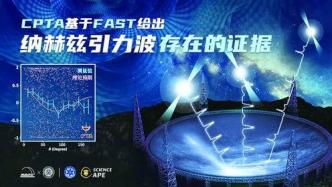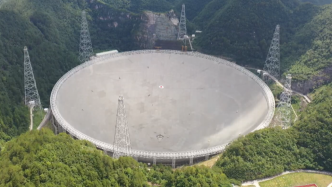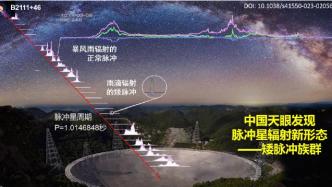

Schematic diagram of the key evidence that FAST detected the existence of nanohertz gravitational waves. Photo courtesy of the National Astronomical Observatory
In an international astronomical competition that started 20 years ago, Chinese scientists came first and successfully verified the theoretical predictions made 40 years ago in just 3 years and 5 months—China Sky Eye FAST has passed the monitoring of 57 pulsars , for the first time "saw" the ripples from the deep universe.
On June 29, the China Pulsar Timing Array (CPTA) research team, composed of researchers from the National Astronomical Observatory of the Chinese Academy of Sciences (hereinafter referred to as the National Astronomical Observatory) and other units, used FAST to detect key evidence of the existence of "nahertz gravitational waves". Relevant papers were published online in my country's astronomical academic journal "Research in Astronomy and Astrophysics (RAA)". At the same time, three other international teams from Europe-India, the United States, Australia and other countries and regions simultaneously published their own independently obtained and mutually confirmed results.
"Humanity is finally standing in front of the long-awaited observation window of nanohertz gravitational waves." Li Kejia, the corresponding author of the paper, a researcher at the National Astronomical Observatory/Peking University, and his team are proud of this. Scientific installations carry out original research, and the results are published in local academic journals in China, and our country has reached the leading level in this field at the same time as the world."
Look for "nahtz"
Einstein once predicted in the general theory of relativity that an accelerating mass object would disturb the surrounding space-time and produce "ripples", which are gravitational waves. For nearly a century, scientists around the world have attempted to observe gravitational waves experimentally.
"If the universe is likened to a glass of water, what humans know and can see is just a drop in it, and most of the universe is invisible dark matter and dark energy." Li Kejia introduced, "We can only have 'quality' by tracking 'The movement of objects can reveal the mysteries of the universe."
Gravitational waves have different frequencies and wavelengths, reflect different astronomical events, and have different detection methods. For example, in 2016, the US Laser Interferometer Gravitational-Wave Observatory (LIGO) directly observed gravitational waves in experiments for the first time. It uses ground-based laser interferometers to observe gravitational waves with higher frequencies and shorter wavelengths. These gravitational waves are produced by the merger of stellar-mass binary black holes.
Gravitational waves with lower frequencies and longer wavelengths are produced by the motion of more massive objects. As the most massive celestial body in the universe, the gravitational waves generated by the revolving supermassive double black hole system in the center of the galaxy are mainly concentrated in the "nahertz frequency band", that is, one billionth of a hertz. In the view of astronomers, the detection of nanohertz gravitational waves will help to understand the growth, evolution and merger process of supermassive black holes.
However, due to the extremely low frequency and the period of several years, the detection of nanohertz gravitational waves is extremely challenging, and scientists around the world have not discovered its traces for a long time.
57 pulsars, 3 years and 5 months
The long-term timing observation of a group of millisecond pulsars with extremely regular rotation using a large radio telescope is currently the only way to detect nanohertz gravitational waves. "The gravitational waves generated by the movement of supermassive celestial bodies will disturb the entire space-time, and will also change the time signal when the pulsar reaches the earth. By comparing these signals, we can judge whether it is a gravitational wave." Rationale for research.
As early as 1983, astronomers had theoretically predicted that "quadrupole-related signals" were characteristic evidence of gravitational waves. With the rapid development of radio astronomy, searching for nanohertz gravitational waves based on this principle has gradually become one of the focuses of scientific competition.
In the past 20 years, the North American Nahertz Gravitational-Wave Observatory (NANOGrav), the European Pulsar Timing Array (EPTA), and the Australian Parkes Pulsar Timing Array (PPTA) have used their large radio telescopes to carry out the Nahertz gravitational-wave search. Recently, new forces such as the Chinese Pulsar Timing Array, the Indian Pulsar Timing Array (InPTA) and the South African Pulsar Timing Array (SAPTA) have been added.
Using FAST, the Chinese pulsar timing array research team achieved the goal in only 3 years and 5 months. Around the relevant data of 57 pulsars, they independently developed independent software for data analysis. Finally, at the "4.6 Sigma Confidence Level" level, evidence of quadrupole-related signals with nanohertz gravitational wave characteristics was found, with a false positive rate of less than one in half a million, successfully verifying the theoretical prediction made 40 years ago.
At the same time, the amplitude of the detected gravitational waves is extremely small, the distance is equivalent to the disturbance caused by gravitational waves on the scale of 1 km, which is about the size of one percent of a hydrogen atom, and the time is equivalent to a change of 1 second on the scale of tens of millions of years.
Li Kejia said that due to the short time span of the current observation data, the scientific research team is temporarily unable to determine the main physical source of gravitational waves in the nanohertz band, but this problem will be resolved as the time span of follow-up observation data increases.
organized basic research
Faced with the unfavorable situation that the observation time span is much shorter than that of international teams, Chinese scientists could not achieve this major breakthrough without the strong support of the management department, the full cooperation of the scientific research team, and the long-term perseverance of the scientists.
Chang Jin, director of the National Astronomical Observatories and academician of the Chinese Academy of Sciences, concluded: "The achievement of this major scientific breakthrough has made us clearly realize that frontier scientific research has entered the era of big science, and international scientific and technological competition has moved forward to basic research. The organization of basic research The degree is getting higher and higher, the goal orientation is more and more obvious, and the important role of institutionalized and institutionalized scientific research is becoming more and more prominent."
It is understood that my country first carried out preliminary research on the pulsar timing array in 2002; in 2016, the Chinese Academy of Sciences launched the "Multi-band Gravitational Wave Cosmic Research" strategic pilot technology project (B category), and cooperated with several related units The Chinese pulsar timing array research team was established; after the establishment of the China SkyEye FAST Science Committee in 2019, it will continue to accelerate the collaborative research on nanohertz gravitational wave detection. At the same time, the Ministry of Science and Technology and the National Natural Science Foundation of China have also deployed related scientific research projects.
In the process of nahertz gravitational wave detection, the scientific research team has continuously improved the observation accuracy of FAST on pulsars on the one hand, and accelerated the innovation of data processing methods on the other hand, making up for the time span with the advantages of data accuracy, pulsar number and data processing algorithms. The gap in size has enabled the rapid improvement of the detection sensitivity of nanohertz gravitational waves in my country.
A group of "post-80s" and "post-90s" young scientists have also gradually grown up in this research. As the person in charge of China's pulsar timing array, Li Kejia, who was born in the 1980s, joined the field in 2003. After 20 years of perseverance, he finally realized his dream.
"The data processing process day after day and year after year is indeed a bit boring, but when you always think that what you do is important, you will always have faith." The first author of the paper, an assistant researcher at the National Astronomical Observatory, "post-90s "Xu Heng said.
Related paper information:
https://doi.org/10.1088/1674-4527/acdfa5
(Original title "Again World-Class Discovery of China's Sky Eye "Sees" Gravitational Waves")


